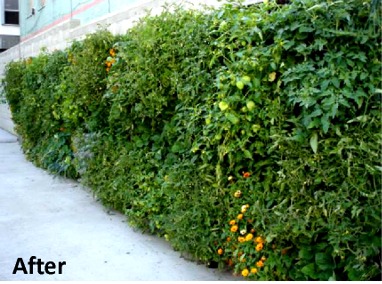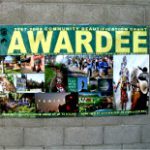
Additional Resources
Skid Row Housing Trust’s “The Rainbow Apartments” is located at 643 S. San Pedro St., Los Angeles, CA 90014. Learn more about Skid Row Housing Trust’s ‘The Rainbow’ at their website here. For more information about the Urban Farming Food Chain?, to donate to Urban Farming or to become a Co-sponsor, please contact: Joyce Lapinsky, Program Development: jlapinsky@urbanfarming.org 323-877-2697, or visit their website. Contact Robin E. Osler, AIA, at: 212.989.0652. Learn all about Green Living Technologies (GLT) in The Greenroof Directory here. George Irwin can be reached for comment or presentations directly at: george@agreenroof.com.
Skid Row Housing Trust?s Rainbow Apartment is a permanent supportive apartment complex for homeless men and women. The Urban Farming Food Chain consists of 750 square feet of edible food-producing Green Living? Walls mounted on buildings, concrete walls, freestanding or in parking areas, growing fresh produce (without the use of pesticides) at four locations in and around downtown Los Angeles, inclusive of the Central City East (Skid Row) area. The organizations that host these edible walls will utilize the food for their own purposes and, as is the paradigm of Urban Farming across the country and overseas, the people who tend the gardens are committed to donating a portion of their harvests to neighbors and/or organizations in need. The Green Living? Wall systems of the Food Chain are as “links” connecting to each location by intention and design, as well as presenting a new definition for the familiar term, ‘food chain’. Los Angeles was the pilot city for the Urban Farming Food Chain, a project being replicated in other cities.(New York, April 2009, Rochester, Detroit, Las Vegas).The gracious hosts and new owners of the Food Chain’s first four walls are: The Weingart Center; The Rainbow Apartments (in partnership with the Yankee Apartments); The Los Angeles Regional Food Bank and the Miguel Contreras Learning Complex. The Food Chain pilot project in Los Angeles is partially funded by gifts and grants with the intelectual property, materials and professional services by Green Living Technologies. The Food Chain is a vertical gardening system that offers immediate access to fresh produce, greens the environment, creates team-building and skills-training, and provides an opportunity for community service and involvement. The Urban Farming Food Chain sites are located where people will greatly benefit from the healthy fresh food and have the opportunity to learn new skills, connect with diverse community members, enjoy the beauty of nature at their fingertips and feel empowered by the process and the gratification of sharing the produce with other people in need.
The installation started with the pre-vegetation and care of the Green Living? Walls at California Polytechnical Institute (Cal Poly). The growing was introduced by a nationally certified teacher (GLT CEO George Irwin, BS) to a Cal Poly class as part of an environmental ciriculum. The installation became an opportunity to work directly with the benefacting population. Green Living? Technologies supervised 4 transitional homeless persons allowing for skill training and an opportunity to create green job opportunities. By day 5, 4 individuals installed the final wall from start to finish, including irrigation with no additional assistance from Green Living? Technologies. It was a true testament to being able to teach a man how to fish. Each Food Chain site has been assigned a Master Gardener to advise and consult, along with local community members who tend to and maintain the vertical gardens and harvest the food as needed. Each of these “edible walls” of the Food Chain measures between 24 to 30 feet across, by 6 feet high, made up of individual (2ft x 2ft x 4″ & 6″ depths) interconnected recycled stainless steel panels, inclusive of a fully automated irrigation system. This is an on going educational program that will continue to teach those in need of skill training and providing and opportunity for job placment in the green industry.This program has also become part of an initial pilot for grades 3-12 as a 6 week introduction to green roofs and green wall technologies designed and implemented by nationally certified teacher and GLT CEO George Irwin aka ?The Green Wall Editor? on Greenroofs.com. The four walls are made up of a total of 180 panels growing approximately 4,000 fruit and vegetable plants. Warm season crops include; tomatoes, cucumbers (green and yellow), strawberries, bell peppers, hot peppers, tomatillos, spinach, parsley, leeks, edible lavender, eggplant, zucchini, Sugar Baby watermelon, and a variety of herbs. Cool season crops include: lettuce varieties, radish, and legumes.The drainage system is free draining by design, built in as a feature of the Green Living? Wall systems. Stainless steel catch basins for re-capture of excess irrigation and/or rain are included at 2 of the 4 locations. The remaining 2 have permeable surfaces. Irrigation consists of a 8mm drip line 6″ on center spacing that correlate to the 6″ spacing of the Green Living? Wall panels which are fully automatic complete with rain sensor set to provide minimal waste water. Maintenance requirements vary from season. The walls are 100% sustainable. The master gardeners are taught to use the seeds from the previous crops to regenerate the wall the following growing season. The spent vegetation is simply cut off at the root level and added to a compost pile. The roots of the previous crop remain in the wall system to become compost and organic material. Since this project is in ideal Southern California the crops are rotated between warm and cool season crops and provide a year round opportunity to grow.
 Greenroofs.comConnecting the Planet + Living Architecture
Greenroofs.comConnecting the Planet + Living Architecture














